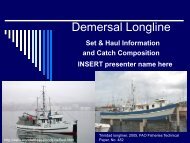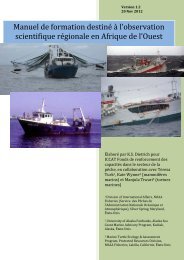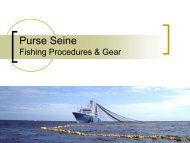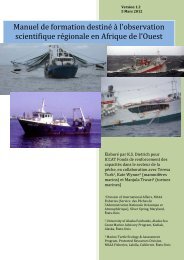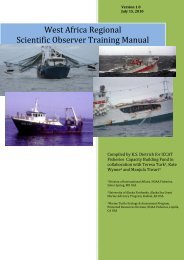- Page 1 and 2: Version 1.1 May 1, 2011 West Africa
- Page 3 and 4: 4.2 Introduction ..................
- Page 5 and 6: 12.4.2 Marine Mammal Carcass Examin
- Page 7 and 8: Acknowledgements The following sour
- Page 9 and 10: • Monitoring consists of the coll
- Page 11 and 12: 1.4.3 International Management Inst
- Page 13 and 14: Figure 1-2 Approximate boundaries o
- Page 15 and 16: 2.4 Rights and Responsibilities 2.4
- Page 17 and 18: • Achieve a basic familiarity wit
- Page 19 and 20: vessel captain with an opportunity
- Page 21 and 22: 3 Essential Information 3.1 Learnin
- Page 23: within the calculation! It is impor
- Page 27 and 28: Figure 3-3 Globe with latitude (lef
- Page 29 and 30: • Collect as large a sample as po
- Page 31 and 32: 3.7 First day(s) on board As soon a
- Page 33 and 34: flagged (Appendix 5). Home port Pre
- Page 35 and 36: Other Water capacity Fuel capacity
- Page 37 and 38: Communications: Circle Yes or No an
- Page 39 and 40: Catch sensors Net sensors Hydrophon
- Page 41 and 42: Refrigeration Blast freeze? Y / N C
- Page 43 and 44: LLD LLS GND Drifting or pelagic lon
- Page 45 and 46: Trip Summary Embarkation Departure
- Page 47 and 48: 5 Catch Composition Form 5.1 Learni
- Page 49 and 50: 7 Pots/traps 8 Other Use for Marine
- Page 51 and 52: Observer code Vessel code Trip ID D
- Page 53 and 54: Figure 6-1 Bottom and midwater traw
- Page 55 and 56: 6.5 Forms/Instructions 6.5.1 Gear D
- Page 57 and 58: Beam and Otter Trawl Section For ea
- Page 59 and 60: Stretched Mesh Opening - Diamond Me
- Page 61 and 62: Figure 6-8 Types of strengthening r
- Page 63 and 64: 6-12
- Page 65 and 66: 6.5.2 Trawl Effort / Total Catch Fo
- Page 67 and 68: Min Long- E/W Depth (bottom) Depth
- Page 69 and 70: Each option is discussed in more de
- Page 71 and 72: 6.6.1.1 Bin Volumes Total catch is
- Page 73 and 74: in order to obtain a volume. Refer
- Page 75 and 76:
Sorting technique of crew- Each ves
- Page 77 and 78:
sampling rate for RST#1 is ~70-72%.
- Page 79 and 80:
Figure 7-1 Shrimp trawler net confi
- Page 81 and 82:
Figure 7-4 Examples of BRDs: A) Fis
- Page 83 and 84:
Warp Bridle (door chain) Top leg li
- Page 85 and 86:
provided). Funnel Distance from esc
- Page 87 and 88:
7-10
- Page 89 and 90:
7.5.2 Trawl Effort / Total Catch Fo
- Page 91 and 92:
Demersal longline length ranges fro
- Page 93 and 94:
Figure 8-2 Gangion configuration. G
- Page 95 and 96:
hooks come on board depends on weat
- Page 97 and 98:
Figure 8-6 Offset (left) and non-of
- Page 99 and 100:
8-22
- Page 101 and 102:
this form is obtained through direc
- Page 103 and 104:
Hooks - Type* Record the dominant h
- Page 105 and 106:
that percent recorded must sum to 1
- Page 107 and 108:
8.8 Catch Composition and Biologica
- Page 109 and 110:
counted. When tally sampling, obser
- Page 111 and 112:
variability caused by setting acros
- Page 113 and 114:
10. Note how many gear units were t
- Page 115 and 116:
9 Pelagic Longline 9.1 Learning obj
- Page 117 and 118:
Figure 9-2 Branchline configuration
- Page 119 and 120:
9.6 Forms/Instructions 9.6.1 Gear D
- Page 121 and 122:
Line setter / shooter - used to pul
- Page 123 and 124:
Figure 9-6 Example Gear Description
- Page 125 and 126:
2. 3. (i.e., away from engine cooli
- Page 127 and 128:
interval Distance between Weight (g
- Page 129 and 130:
Figure 9-8 Example of completed Set
- Page 131 and 132:
shark breaks the surface & then the
- Page 133 and 134:
using the following definitions: Bl
- Page 135 and 136:
hooks’. Most of the time, you sho
- Page 137 and 138:
7. Record fishing gear characterist
- Page 139 and 140:
Figure 10-2 Diagram of backdown pro
- Page 141 and 142:
Total length = total count of hand
- Page 143 and 144:
Comments Note the general condition
- Page 145 and 146:
activities. The information recorde
- Page 147 and 148:
on the binoculars and/or bird radar
- Page 149 and 150:
Long-Deg Long-Min Record degrees of
- Page 151 and 152:
To ascertain whether the helicopter
- Page 153 and 154:
Object No. Sighting No. Set No. Com
- Page 155 and 156:
any details in COMMENTS. If the obj
- Page 157 and 158:
10-22
- Page 159 and 160:
Association How Detected Set Sequen
- Page 161 and 162:
as follows: 6A - Whole brail - all
- Page 163 and 164:
Figure 10-10 Example of Set Informa
- Page 165 and 166:
All Atlantic blue marlin Makaira ni
- Page 167 and 168:
The snout should be resting gently
- Page 169 and 170:
pectoral girdle. It is the bony ant
- Page 171 and 172:
Figure 11-3 Male opah (Lampris gutt
- Page 173 and 174:
Cross section (left) and whole (rig
- Page 175 and 176:
typically collected for aging purpo
- Page 177 and 178:
11.4.2 Invertebrates 11.4.2.1 Stand
- Page 179 and 180:
Carapace length (37) Posterior edge
- Page 181 and 182:
Figure 11-9 Sex differences in lobs
- Page 183 and 184:
some cases, speed of travel. A gree
- Page 185 and 186:
• Marine mammals • Sea turtles
- Page 187 and 188:
Table 11-4): 01 Fork 02 Total (fish
- Page 189 and 190:
2b - spine/ray 2c - otoliths 3 - st
- Page 191 and 192:
Tag type Tag location Tag color Who
- Page 193 and 194:
• Species ID forms are required f
- Page 195 and 196:
12.3.2.1 Landing and Handling Upon
- Page 197 and 198:
Figure 12-3 Examples of mouth opene
- Page 199 and 200:
3. Sea turtles that revive and beco
- Page 201 and 202:
Photos taken: Video? Closest Approa
- Page 203 and 204:
Marine Mammal Capture Boarded vesse
- Page 205 and 206:
Section caught Animal was able to s
- Page 207 and 208:
12-14
- Page 209 and 210:
Fgure 12-6 Examples Marine Mammal a
- Page 211 and 212:
many species. Starting at the front
- Page 213 and 214:
collected. Figure 12-7 Example Mari
- Page 215 and 216:
Carapace width Width is the maximum
- Page 217 and 218:
Capture Information Date Fill in th
- Page 219 and 220:
Was a light stick on the hook? Ligh
- Page 221 and 222:
Figure 12-8 Example of Sea Turtle C
- Page 223 and 224:
Figure 12-10 Example Seabird Identi
- Page 225 and 226:
13.2.3 Document Fully document any
- Page 227 and 228:
Billfish (BIL) 06-09 Bycatch (BYC)
- Page 229 and 230:
Figure 13-2 Example of a completed
- Page 231 and 232:
The FAO IPOA-IUU requests nations t
- Page 233 and 234:
form. Activity Speed Hull Material
- Page 235 and 236:
Lat-Min Lat-N/S Long-Deg Long-Min L
- Page 237 and 238:
16 Health & Safety Information 16.1
- Page 239 and 240:
Talk with the crew about safe place
- Page 241 and 242:
The vessel may have some on board.
- Page 243 and 244:
16.6.2 Hyperthermia & Hypothermia H
- Page 245 and 246:
• Intimidating an observer. • B
- Page 247 and 248:
2. Refrain from wearing potentially
- Page 249 and 250:
16.7.1.1 Survival craft Life rafts
- Page 251 and 252:
16.7.1.3 Personal flotation devices
- Page 253 and 254:
long distances 16.7.1.5 Emergency C
- Page 255 and 256:
suits on the beach) is an internati
- Page 257 and 258:
sweeping motion (Figure 16-10). Kee
- Page 259 and 260:
Figure 16-11 Righting the life raft
- Page 261 and 262:
equipment High water alarm Watertig
- Page 263 and 264:
17 References ACCSP. 2004. The Prog
- Page 265 and 266:
FAO. 2005-2009. Fishing gears and m
- Page 267 and 268:
Schneider, W. 1990. FAO species ide
- Page 269 and 270:
Radio, 3-4 emergency channel, 3-4,
- Page 271 and 272:
Appendix 4. List of Known IUU Vesse
- Page 273 and 274:
Appendix 5. Country & IRCS Codes FA
- Page 275 and 276:
Appendix 6. Fishing Gear Codes Full
- Page 277 and 278:
Appendix 7. Species Names and Codes
- Page 279 and 280:
Apterichtus gracilis Ophichthidae A
- Page 281 and 282:
TCY Trachinocephalus myops Snakefis
- Page 283 and 284:
Distichodus hypostomatus Citharinid
- Page 285 and 286:
BGO Bathygadus macrops Bullseye gre
- Page 287 and 288:
MDH Microdesmus aethiopicus Microde
- Page 289 and 290:
Lampanyctus nobilis Noble lampfish
- Page 291 and 292:
nuchipinnis MTF Malacoctenus africa
- Page 293 and 294:
Apogon imberbis Cardinalfish Apogon
- Page 295 and 296:
EHN Echeneis naucrates Live sharksu
- Page 297 and 298:
tasselfishes nei nca WRF Polyprion
- Page 299 and 300:
DEC Dentex dentex Common dentex Den
- Page 301 and 302:
DHZ Dicologlossa hexophthalma Ocell
- Page 303 and 304:
DLT Diplospinus multistriatus Strip
- Page 305 and 306:
SSW Scorpaena angolensis Angola roc
- Page 307 and 308:
Argyropelecus sladeni Sladen's hatc
- Page 309 and 310:
Stomias lampropeltis Stomiidae STOM
- Page 311 and 312:
Bembrops greyi Roundtail duckbill P
- Page 313 and 314:
PTM 18-46 Pseudotriakis microdon Fa
- Page 315 and 316:
CWO Centrophorus spp Gulper sharks
- Page 317 and 318:
BYH Bathyraja hesperafricana West A
- Page 319 and 320:
CSS Scleractinia Hard corals, madre
- Page 321 and 322:
MTS Squilla mantis Spottail mantis
- Page 323 and 324:
B.brydei) BLW Balaenoptera musculus
- Page 325 and 326:
WAM Trichechus senegalensis West Af
- Page 327 and 328:
Appendix 8. International and Natio
- Page 329 and 330:
Appendix 10. Common Formulas & Conv
- Page 331 and 332:
Appendix 11. Random Number Tables H
- Page 333 and 334:
Appendix 12. Sea State Beaufort Win
- Page 335 and 336:
Appendix 14. International Conventi
- Page 337 and 338:
Appendix 15. CITES Listed Marine Ve
- Page 339 and 340:
Appendix 16. Glossary / Acronyms Ab
- Page 341 and 342:
Chase 4 - Pursuing marine mammals w
- Page 343 and 344:
confused with terms such as deadwei
- Page 345 and 346:
REC - Regional Economic Communities
- Page 347:
18-80



